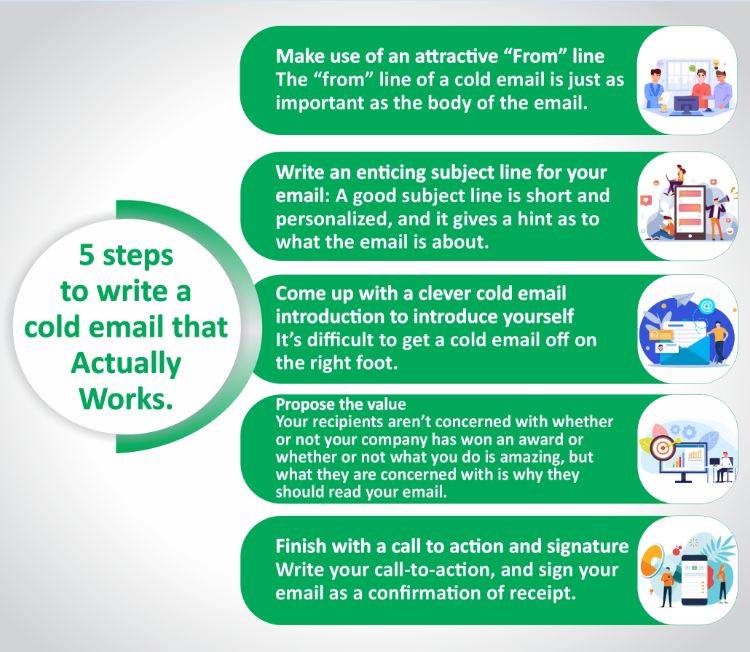
Introduction
Cold email is a technique for initiating communication in the online world. Cold emails are introductory messages sent by salespeople to cold leads with the goal of pitching a product or service and prompting them to take action, which is usually scheduling a sales call. In this case, you’re sending a message to someone who, most likely, knows nothing or very little about your organization.
We refer to them as “cold” leads because since it is the first time they’ve heard of you and are therefore unfamiliar with your brand. The goal of a cold email is not immediate conversation but to nurture the relationship and help them progress from strangers to potential business partners. Knowing how to quickly and effectively create a personalized cold email will assist you in generating more leads for your company. Here are the steps for writing a cold email that works:
- Make use of an attractive “from” line
- Write an enticing subject line for your email
- Come up with a clever cold email introduction to introduce yourself
- Propose the value
- Finish with a call-to-action and signature
-
Make use of an attractive “from” line
The “from” line of a cold email is just as important as the body of the email, and that’s because it plays an important role. It identifies the sender of the email to the recipients of the message. What follows is that they decide whether or not to open the message and read it, or whether or not to throw it away and forget about it.
If you’re conducting a cold outreach campaign, the appropriate “from” line will be determined by the context of your message, the audience you’re trying to reach, and the goal of your email, which may be marketing collaboration, influencer outreach, or a potential sales deal.
-
Write an enticing subject line for your email
A good subject line is short and personalized, and it gives a hint as to what the email is about. Most importantly, it persuades the lead that the email is specifically addressed to him or her individually. A poorly written subject line may have an adverse effect on the recipient’s perception of us and our email. Some recipients may choose not to open the email or, worse, may manually mark it as SPAM, resulting in issues with email deliverability.
An interesting thing we’ve noticed is that these subject lines in this collection follow three distinct “need” patterns. They are all referring to a prospect’s desire to improve, change, or innovate in one way or the other. The combination of addressing prospects’ primary concerns while also personalizing the subject lines is what makes these subject lines so successful for marketers.
-
Come up with a clever cold email introduction to introduce yourself
It’s difficult to get a cold email off on the right foot. The length of a cold email introduction should not be more than two or three sentences. It is not intended to serve as an introduction to us or our company for the prospect. This phrase refers to the expertise, accomplishments, work and company of the recipient of the message rather than to themselves. Additionally, it make it clear that this email is being sent to them specifically.
The introduction should be treated as an opportunity for you show your prospects that they received your message as a result of your specific contact. You did not contact them on the spur of the moment. You took your time and thought about your approach. The best way to do that is to include information about the lead in the first sentence, such like a common interest or a recent promotion. It is acceptable to use their company name or job title instead if this is not possible.
-
Propose the value
Your recipients aren’t concerned with whether or not your company has won an award or whether or not what you do is amazing in every way but what they are concerned with is why they should read your email. You make contact with prospects in the hopes of converting them into paying clients. If you want to achieve this, you must demonstrate what is currently wrong with their system and why they should seek to change it.
For this reason, once you’ve established a strong opening line, you should get right to the point and explain why you’re reaching out to them. What can you do to assist in this situation? The benefits of establishing a business relationship with you, as well as examples of how your offering is beneficial to other businesses, are discussed.
-
Finish with a call-to-action and signature
There aren’t too many steps in this process. Once they have received and read your email, what do you hope they will do? It could be to set up a meeting, respond to an email, or sign up for your solution, among other things. Whatever you want them to do, keep your call to action as straightforward as possible.
Write your call-to-action, and sign your email as a confirmation of receipt. When asking the lead to take specific next steps with you, make sure to end on a respectful note and include all of the lead’s contact information in your final email signature.
It is possible to condense the email body by using a well-crafted signature, which will help us to focus the message on the intended recipient. There is no way around the fact that our signature is an essential part of our message. It should provide our addressee with information about our identity and direct them to additional information about us and/or our company.

